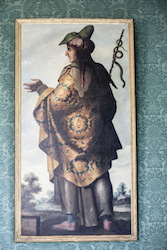Firstly, a bit of history. In 1756, Bishop Trevor commissioned a series of paintings entitled Jacob (Israel) and his Twelve Sons by the Spanish Old Master Francisco de Zurbarán as a public statement against the repeal of the Jewish Naturalisation Act. Several years ago, the Church of England announced plans to sell these paintings to finance the refurbishment of the castle, and Jonathan Ruffer, a successful hedge fund manager originally from the region, offered to purchase them, sight unseen for £15m to prevent them leaving their historic home. After much wrangling, the Church consented to the sale, on the condition that Ruffer also took on responsibility for the castle, which after further wrangling he agreed to.
Auckland Castle is now the focus of a £50 million redevelopment that will position it as an internationally significant centre for religious art with the aim that this will in turn provide the catalyst for a range of new socio-economic opportunities in what is a very deprived region. The Zurbarán portraits are the catalyst for the regeneration of not only the castle but the town of Bishop Auckland itself.

The Long Dining Room with Zurbarán portraits
Having a wealthy philanthropist in charge has clearly led to the development of a dynamic environment at the Trust. The 31 staff (currently) who work at the Castle are at the beginning of an exciting time which will see them effectively build a new heritage attraction from scratch, from collections management systems and catering to exhibition development, restoration and ticketing.
The church commissioners used to open the castle to visitors, but in the final year before Ruffer’s arrival a mere 800 visitors walked through its impressive gate. With 7,000 visitors achieved in the first year of Ruffer’s stewardship and a forecast of 15,000 this year, there are ambitious plans to generate around 190,000 visitors per year.
Liz Fisher, who arrived at the Museum earlier this year, is helping to put the next stage of their £17m Heritage Lottery Fund bid together. She has been carrying out research amongst visitors to find out how they feel about pricing, facilities and the wider town of Bishop Auckland itself. Responses gathered so far will help to inform this next stage of the HLF bid.
The state rooms will be restored to add to the feel and experience of the place. They currently act a bit like a corridor, with visitors rushing through to see the Zurbarán portraits. “The idea”, says Clare Baron, “is to add drama and restore the original feel.” Having carried out paint analysis throughout the building, which has revealed the dramatic and bold colours that would have been used, the next step is to pinpoint the moment in time that will then be focused on for the restoration. A community archivist is working on the local history of the building and the surrounding community so that the back story for the site can be developed. On top of this says Baron, “there are plenty of personal stories to add flavour.”

Dan from Francisco de Zurbaran's series Jacob and his 12 Sons
The Zurbaráns themselves have never been conserved; the paintings of Jacob and his twelve sons still hang in the (formerly fire lit) dining room that was built for them. Paint analysis by the Northumbria University Conservation Department is being carried out on the paintings and once the castle has been restored, they will be reintroduced gradually to their home, to ensure that the new, museum-quality environmental controls will not damage them.
Although the castle is in good repair, key work needs to be carried out to ensure that it is able to host national and international exhibitions. Re-wiring, new heating and environmental controls are just some of the works that are planned. On top of this, there are ambitious plans for a geo-thermal project which will tap into a natural spring below the building which will, it is hoped, provide energy to heat not only the castle but other buildings on the estate. The currently derelict walled garden is being redeveloped.
The redesign of the site will also mean that visitors are drawn through Bishop Auckland, from many car parks in the town. A new art gallery will be based in the pretty market square which lies outside of the castle walls, and the new welcome building, designed by architect Niall McLaughlin Associates, will feature a tower platform which will allow visitors to look both into the castle grounds and out across the town. During the works, hard hat tours will be carried out so that visitors can see the newly refurbished castle emerge.
One of the most exciting initiatives is that Auckland Castle, along with The Bowes Museum (which itself has a huge collection of Spanish Golden Age Art) and Durham University, is establishing a unique collaboration with Spain’s Museo Nacional del Prado. A Symposium of Spanish Art is planned for October of this year where experts from the Museo del Prado, the National Gallery in London and others will deliver a range of papers relating to 17th century Spanish Art. The trust and their partners at Durham University and the Bowes Museum plan this as the start of a new centre of excellence for the study of Spanish Art in County Durham.
This huge project is already two years into its five-year plan for redevelopment. Due to open in 2018, over the next three years, M+H Advisor will be re-visiting the site and keeping up with the works as Auckland Castle turns from bishops’ palace into international visitor attraction.
Back to top




